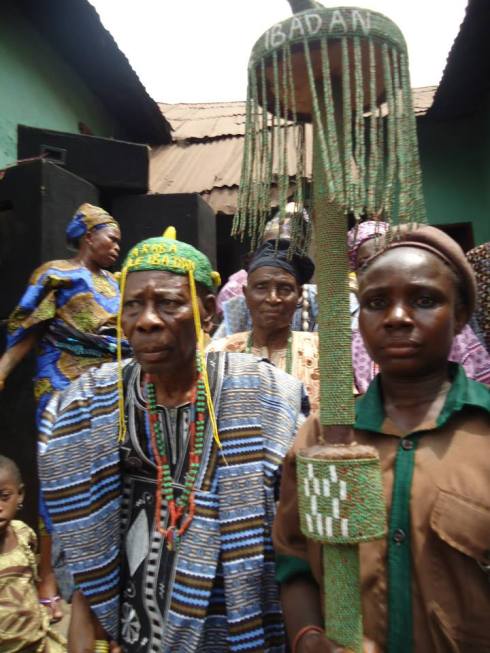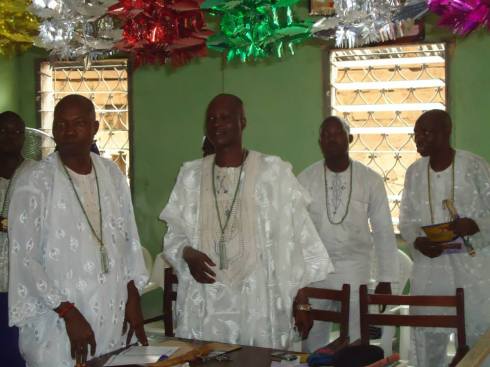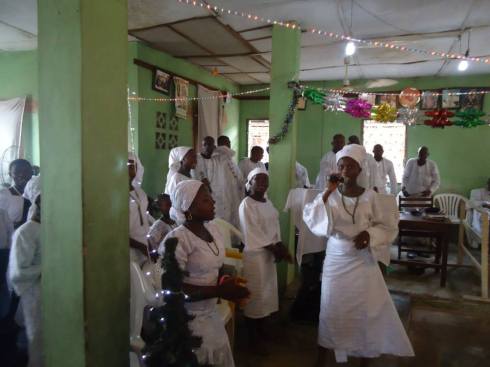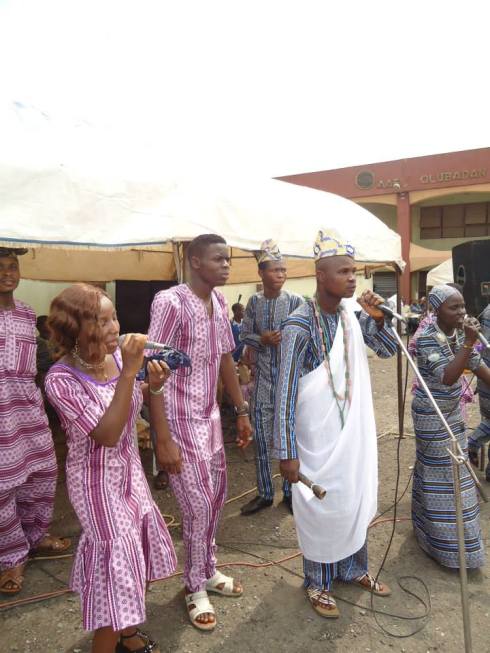-
Osemeji Festival
Aboru Aboye o,
Yoruba believe that main Odu’fa came from heaven. The Oju Odu’fa were sixteen in number and Odu’fa Ose-meji is number fifteen.
Yoruba believe that main Odu’fa came from heaven. The Oju Odu’fa were sixteen in number and Odu’fa Ose-meji is number fifteen.
The meaning of Ose-Meji, as it comes out
from the divination that Ose made when coming to the world from heaven
to become relevant, Ose was told of having so much enemies both on earth
and in heaven, he then asked to make a sacrifice to conquer all these
enemies, He did as Awo said, and He conquered in heaven and on earth (
Ose segun ni Aye ati Orun) makes him a victor in two places, He was
since then called Osegun-Meji which is believed to have been shortened
to Ose-Meji today. He then talked of how Ose-Meji came in to Ibadan and
met the founder of the city Lagelu,who asked Ose-Meji to make a
divination for him to make Ibadan big with high population.
Odu’fa Ose-meji came specifically to Ibadan. In its some of the verses, the one, which deals with its coming to Ibadan reads thus:
Odu’fa Ose-meji came specifically to Ibadan. In its some of the verses, the one, which deals with its coming to Ibadan reads thus:
Ibere agba bi eni naro lori,
A difa fun Ose.
Ti ns’awoo re ode Ibadan
O ni Ode Ibadan ti oun nlo yii
Oun le rire nibe
Nwon ni ebo ni ki o waa ru
Nwon ni pipo ni rere re
O si ruu.
Osi ni Opolopo aje.
O ni be e gege
Ni Awo oun fenu rere ki Ifa
A difa fun Ose.
Ti ns’awoo re ode Ibadan
O ni Ode Ibadan ti oun nlo yii
Oun le rire nibe
Nwon ni ebo ni ki o waa ru
Nwon ni pipo ni rere re
O si ruu.
Osi ni Opolopo aje.
O ni be e gege
Ni Awo oun fenu rere ki Ifa
Ibere agba bi eni naro lori
Adia fun Ose
Ti nsawoo rode Ibadan
Aje de o niso.
O roo mi a da yaya,
Aje je nri o mu so kum
Aje je nri o mu se ide.
Adia fun Ose
Ti nsawoo rode Ibadan
Aje de o niso.
O roo mi a da yaya,
Aje je nri o mu so kum
Aje je nri o mu se ide.
Before Lagelu and his people left the hill in the bush to found the present Ibadan he consulted Ifa Oracle.
Upon realizing his folly, which led to the total destruction of his first, Ibadan settlement, because of his rejection of Awo Ateka’s prophecy, he did not want to fall into such an error again. He consulted Awo Ateka for help about his proposed new Ibadan settlement. Ateka refused persistently to help, because of the levity with which Lagelu treated his (Ateka’s) earlier prophecy. As Lagelu was appealing and persuading Ateka, Ose-meji, a brother to Ateka intervened and it was resolved that Ose-meji should help Lagelu about his proposed settlement.
Then Ose-meji asked Lagelu to leave the hill in the bush for a place called “Oriyangi” (which is at the present Ose-Meji Temple). But before Lagelu could leave for the new Ibadan settlement, certain rituals and sacrifices must be performed at the new site, and that Lagelu should provide all the materials needed for the rituals and sacrifices. The materials were in groups of two hundred each type as enumerated below:
Upon realizing his folly, which led to the total destruction of his first, Ibadan settlement, because of his rejection of Awo Ateka’s prophecy, he did not want to fall into such an error again. He consulted Awo Ateka for help about his proposed new Ibadan settlement. Ateka refused persistently to help, because of the levity with which Lagelu treated his (Ateka’s) earlier prophecy. As Lagelu was appealing and persuading Ateka, Ose-meji, a brother to Ateka intervened and it was resolved that Ose-meji should help Lagelu about his proposed settlement.
Then Ose-meji asked Lagelu to leave the hill in the bush for a place called “Oriyangi” (which is at the present Ose-Meji Temple). But before Lagelu could leave for the new Ibadan settlement, certain rituals and sacrifices must be performed at the new site, and that Lagelu should provide all the materials needed for the rituals and sacrifices. The materials were in groups of two hundred each type as enumerated below:
Igba ahun = 200 tortoise
Igba eku = 200 rats
Igba eja = 200 fish
Igba abo adie = 200 hens
Igba akuko = 200 cocks
Igba ewure = 200 goats
Igba agutan = 200 sheep
Igba Igbin = 200 snails
Igba ilako = 200 ”
Igba Irere = 200 water tortoise
Igba Obi = 200 kola nuts
Igba atare = 200 Alligator-pepper
Igba Orogbo = 200 bitter-kola
Igba eku = 200 rats
Igba eja = 200 fish
Igba abo adie = 200 hens
Igba akuko = 200 cocks
Igba ewure = 200 goats
Igba agutan = 200 sheep
Igba Igbin = 200 snails
Igba ilako = 200 ”
Igba Irere = 200 water tortoise
Igba Obi = 200 kola nuts
Igba atare = 200 Alligator-pepper
Igba Orogbo = 200 bitter-kola
Plenty of palm oil and a (hunchback man) “Abuke kan” who will accompany the sacrifices to Orun.
All the enumerated materials except “Abuke” were ready at the site for the ritual and sacrifices. Then Lagelu as demanded by Ose-meji could not get “Abuke” and without the necessary rituals and sacrifices at the new site Lagelu could not settle there.
Fortunately at the time and place of the rituals, Ose-meji’s Ifa apprentice named “Fabambo” who was a hunchback man (Abuke) was present. Ose-meji’s full determination to help Lagelu, made him (Osemeji) to give consent to the use of his Ifa apprentice “Omo awo Fabambo” for the ceremony. So, following a hint from Ose-meji, Fabambo agreed to be used.
All the enumerated materials except “Abuke” were ready at the site for the ritual and sacrifices. Then Lagelu as demanded by Ose-meji could not get “Abuke” and without the necessary rituals and sacrifices at the new site Lagelu could not settle there.
Fortunately at the time and place of the rituals, Ose-meji’s Ifa apprentice named “Fabambo” who was a hunchback man (Abuke) was present. Ose-meji’s full determination to help Lagelu, made him (Osemeji) to give consent to the use of his Ifa apprentice “Omo awo Fabambo” for the ceremony. So, following a hint from Ose-meji, Fabambo agreed to be used.
All the necessary ceremonies were performed as planned by Ose-meji for Lagelu and his people at Oriyangi.
On completion of the necessary rituals and sacrifices, sixteen people, eight males and eight females were chosen to carry the sacrifices (Ebo). The “Ebo” were in sixteen bits and the people were ordered to carry it in two groups into two different directions. Osemeji said that Ibadan would extend to wherever the carriers of “Ebo” stopped. (The carriers never returned.) Ose-meji then told Lagelu to worship Odu’fa Ose-meji yearly with the same set of materials used except a hunch-back man (Abuke) who was later replaced to a big cow with hunch back. He asked Lagelu to worship Oke’Badan as well, saying “Ibi ti a ba ti gun ni ati te”. He further directed that Lagelu should be buried on the hill when he died. He prayed for Lagelu that he would prosper and be famous at his new settlement.
Ose-meji then put the tail end of his “Opa Osun” Osun Staff into the ground and disappeared from the spot.
Around this mound – “Oriyangi” Lagelu and his followers built houses and established a market, which has become very famous in Ibadan. It is now called Oja-Oba, Ibadan. This settlement prospered and people from other parts of Yorubaland began to settle there permanently.
Lagelu and his people attributed their success to the kindness of Odu’fa Ose-meji and the spirit of the hill, and since then, Lagelu and his people had been worshipping Odu’fa Ose-meji and Oke’ Badan. Till today Oke’Badan is being worshipped by the people of Ibadan annually and Lagelu’s grave has become a shrine where Ibadan people go to pay homage during Oke’Badan festival every year.
On completion of the necessary rituals and sacrifices, sixteen people, eight males and eight females were chosen to carry the sacrifices (Ebo). The “Ebo” were in sixteen bits and the people were ordered to carry it in two groups into two different directions. Osemeji said that Ibadan would extend to wherever the carriers of “Ebo” stopped. (The carriers never returned.) Ose-meji then told Lagelu to worship Odu’fa Ose-meji yearly with the same set of materials used except a hunch-back man (Abuke) who was later replaced to a big cow with hunch back. He asked Lagelu to worship Oke’Badan as well, saying “Ibi ti a ba ti gun ni ati te”. He further directed that Lagelu should be buried on the hill when he died. He prayed for Lagelu that he would prosper and be famous at his new settlement.
Ose-meji then put the tail end of his “Opa Osun” Osun Staff into the ground and disappeared from the spot.
Around this mound – “Oriyangi” Lagelu and his followers built houses and established a market, which has become very famous in Ibadan. It is now called Oja-Oba, Ibadan. This settlement prospered and people from other parts of Yorubaland began to settle there permanently.
Lagelu and his people attributed their success to the kindness of Odu’fa Ose-meji and the spirit of the hill, and since then, Lagelu and his people had been worshipping Odu’fa Ose-meji and Oke’ Badan. Till today Oke’Badan is being worshipped by the people of Ibadan annually and Lagelu’s grave has become a shrine where Ibadan people go to pay homage during Oke’Badan festival every year.






No comments:
Post a Comment